If you run a B2B service company, you want predictability without babysitting another channel. I want the same thing: a plan that shows where the money goes, when the leads show up, and how fast pipeline grows. That is exactly what a disciplined 90-day Google Ads optimization plan is built to deliver. Not a black box. Not magic. Just a clear sequence of setup, learning, and scaling that maps to the KPIs you already track.
90-day Google Ads optimization plan overview
I treat this as a three-part sprint with tight checkpoints. The plan moves from clean setup to smart iteration to controlled growth. Each phase has its own KPIs and guardrails so I can spot progress early and steer with data, not gut feel. For a step-by-step companion to this plan, see the Google Ads Optimisation Checklist.
-
Days 1 to 30: Foundation
- What happens: Tracking and data integrity are verified; account structure mirrors service lines and funnel stages; keywords are grouped by intent; responsive search ads match message to query; audiences and extensions are set; bidding starts with learning-friendly settings.
- Milestones: 90-95% tracking accuracy validated; search term relevance above 75%; first qualified leads; baseline CPL established.
- KPIs: CPL baseline, qualified lead volume, and first-attribution SQLs if the sales cycle is short.
-
Days 31 to 60: Optimization
- What happens: Query-driven pruning and expansion; controlled ad testing; shift to conversion-focused bidding once volume allows; conversion-path fixes on landing pages; tighter audience layering.
- Milestones: 15-30% CPL improvement versus baseline; higher lead quality; SQL rate rising; early opportunities opened in the CRM.
- KPIs: CPL trending down week over week, SQL rate up, pipeline dollars created.
-
Days 61 to 90: Scale
- What happens: Budget increases tied to CPA guardrails; expansion of top themes and geos; more landing page variants for winners; automation for routine tasks; Offline Conversion Import to bias toward qualified deals.
- Milestones: Cost per qualified lead steady or trending down while spend rises; greater impression share on money terms; predictable week-over-week lead flow.
- KPIs: Cost per SQL, opportunities created, pipeline added, early ROAS view.
Google Ads results timeline
Ads turn on fast. Revenue follows your sales cycle. In B2B, I plan for quick wins while setting up compounding gains - both can be true at once.
-
Week 1 to 2
- Quick wins: cleaner queries, better ad relevance, accurate conversion tracking, early MQLs from branded and high-intent terms.
- What not to expect: stable CPCs or perfect CPL. The system is still learning.
-
Week 3 to 4
- Quick wins: first CPL improvements from negatives, tighter match usage, and early ad message tests.
- Compounding gains: stronger Quality Scores and lower CPC on relevant terms; first warm SQLs if the cycle is short or if bottom-of-funnel offers exist.
-
Month 2
- Quick wins: shift select campaigns to Max Conversions or Target CPA where volume allows. Landing page tweaks that reduce drop-off.
- Compounding gains: better close rates from improved message match and audience layers; first opportunities appear in the CRM for mid-cycle deals.
-
Month 3
- Quick wins: budget increases on proven themes without breaking CPA.
- Compounding gains: rising pipeline from opportunities sourced in Months 1-2, improved Cost per SQL, steadier lead quality.
Note: Google’s guidance generally suggests 15-30 conversions in 30 days before relying on automated strategies like Target CPA. I use that as a floor, not a ceiling.
Days 1-30: B2B Google Ads foundation
The first month is about clean data and a structure that mirrors how you sell. I set the table before I eat.
-
Tracking and attribution
- Implement a tag manager, GA4, and Google Ads conversion actions for form submits, call clicks, and booked meetings.
- Turn on enhanced conversions. Import calls as conversions only when qualified.
- Connect the CRM (e.g., HubSpot, Salesforce) for Offline Conversion Import. Pass back Qualified, Opportunity, and Closed Won so bidding learns what matters.
-
Account structure that mirrors your funnel
- Split campaigns by service line and intent stage: Brand; High-Intent Nonbrand; Problem-Aware; and Competitor Discovery if needed.
- Within each, group ad groups by tight themes to preserve relevance. Keep it simple enough to gather data.
-
Keyword research by intent
- High intent: service + pricing/demo/consultant/agency.
- Mid intent: solution and use-case terms.
- Early intent: pain or job-to-be-done keywords that still show commercial intent.
- Build and maintain a negative list: competitor junk, job seekers, DIY, and student searches. Protect brand with exact match.
-
Ad build with message-market fit
- Use Responsive Search Ads with clear value props and proof. Pin at least one headline stating who you serve and the core offer; test an urgency or risk reducer in another pinned slot.
- Add sitelinks for key pages, callouts for trust signals, structured snippets for services, and a phone extension if calls convert.
-
Geo, schedule, and audience basics
- Target locations sales can support and exclude low-value regions.
- Start with business hours and expand as data supports it.
- Add audiences in observation: remarketing, customer lists, and high-intent in-market segments. Observe first; adjust based on performance.
-
Bidding and budgets
- Start with Max Clicks or Manual CPC with ECPC when conversion volume is low.
- Give each campaign a daily budget that can drive at least 15-20 clicks on core terms to escape starvation.
I keep a weekly note: what changed, what stayed the same, and what to test next. That habit prevents random switches and messy attribution.
Days 31-60: Google Search Ads optimization
Now the data starts talking. I make small, clear moves and let each change run long enough to be real.
-
Tighten match types and negatives
- Review the Search Terms Report twice a week. Remove irrelevant modifiers, find patterns, and add shared negatives to keep spend in high-intent lanes.
-
Query-driven expansion
- Promote strong converting queries to exact match. Build new ad groups only when a theme proves it can win.
-
Ad testing cadence
- Keep 2-3 RSAs per ad group. Test one variable at a time (e.g., headline pinning vs. open rotation, a swapped proof point).
- Use statistical thresholds, not vibes. Freeze winners and move to a new micro test.
-
Bid strategy transition
- When a campaign hits 20-30 conversions in 30 days with solid quality, test Max Conversions, then Target CPA. Log start dates and targets so effects are clear.
-
Conversion-path fixes
- Landing page micro changes drop CPL fast: headline that mirrors the keyword, proof blocks near the form, fewer fields, visible privacy notes, and a scheduling widget if your motion supports it.
-
Audience layering and adjustments
- Add in-market and custom segments aligned to your ICP. Keep in observation mode first. If a segment beats baseline by 20%+ for two weeks, add a positive bid adjustment; if it lags, trim.
One counterintuitive truth: sometimes a higher CPC lowers final CPL because you win better placement on the right queries. I let the math, not the click price, lead.
Days 61-90: scale with guardrails
I scale what proves profitable - not what is merely busy. Spend decisions are tied to CPA guardrails to protect compounding gains.
-
Budget increases with CPA guardrails
- If a campaign beats target CPA by 15%+ for two weeks, increase budget by 10-20%. If it exceeds target by the same margin, hold or reduce until fixes land.
- Make one budget increase per campaign every two weeks to avoid algorithm whiplash.
-
Expansion of top performers
- Geos: clone winning structures into adjacent regions with similar buyer profiles and watch for local quirks.
- Hours and devices: add evening slots if qualified leads arrive after hours. Split mobile/desktop if performance differs by 20%+.
-
Ad and coverage expansion
- Use Dynamic Search Ads to capture long-tail gaps; layer negatives to keep DSA clean.
- Add call ads if your team closes well on the phone.
-
Automation for routine tasks
- Use rules or scripts to pause zero-conversion spend, pace budgets, and alert on tracking breaks or anomalous CPL.
-
LTV focus with Offline Conversion Import
- Import Qualified and Opportunity stages so bidding prefers clicks that become revenue, not just form fills. If one campaign shows a higher CPA but creates bigger pipeline, I favor it. Quality beats cheap every time.
Landing pages that convert B2B traffic
B2B paths can be clunky. The page should reduce doubt, match the searcher’s words, and speed the next step.
-
Above the fold clarity
- Headline mirrors search intent; subhead states outcomes; one clear CTA.
-
Trust and proof near the form
- Logos, short results, or review snippets close to the CTA. Short copy beats a wall of text.
-
Frictionless forms
- Ask only what sales needs for a first call. Use progressive profiling later. Add privacy and response-time notes.
-
Scheduling
- If your motion supports it, embed a scheduler so qualified buyers pick a time and bypass inbox ping-pong.
-
Message match and variants
- Create a variant per top keyword theme. Keep hero and CTA consistent with the ad. Test one major element per variant (headline, hero, or fields).
-
Speed and reliability
- Aim for sub-2-second time to interactive on mobile. Compress images, minimize heavy scripts, and preconnect critical assets.
-
Analytics
- Add heatmaps and session recordings. Tag key events and mark drop-off fields. Share learnings with sales so pages address real objections.
Reporting, governance, and ROI
I report like a CFO would expect: clear checkpoints that tie spend to pipeline and, over time, revenue.
-
Core metrics
- CPL: cost per lead that meets an agreed bar.
- SQLs: sales-accepted leads that pass your qualification filter.
- Cost per SQL: the real buying signal.
- Pipeline created: opportunity dollars tied to the date range.
- ROAS: revenue-to-spend ratio over a rolling window; early on, pipeline is the leading indicator.
-
Sample checkpoints (directional, calibrate to your economics)
- By Day 30: CPL baseline set, first SQLs if the cycle is short, tracking verified. Example: $120 CPL, 15% SQL rate, one opportunity opened.
- By Day 60: CPL improved ~20%, SQL rate up to ~20%, several opportunities opened. Example: $95 CPL, eight SQLs, $150k pipeline started.
- By Day 90: steady CPL at higher spend, consistent SQL rate, opportunities moving to later stages. Early ROAS view from quick-close deals.
-
Break-even and payback framing
- If the average deal is $40k with a 20% close rate and Cost per SQL is $400, I need five SQLs per closed deal. That is ~$2k in SQL cost to win $40k in revenue. Even with sales costs, the payback window is healthy if lead quality holds.
-
Operating hygiene and cadence
- Weekly scorecard: spend, CPL, SQLs, top queries, tests in flight, blockers - ten minutes, same format every week.
- Monthly summary: what improved, what scaled, what stopped, what is next; show pipeline by source from the CRM, not just the ad account.
- Data integrity owners: one marketing and one sales owner confirm tracking and follow-up.
- SQR cadence and n-grams: recurring reviews to harvest winners and cut waste.
- Change log and QA: document changes, confirm tags fire, pages load fast, and ads render as expected.
The punchline is simple. A disciplined 90-day Google Ads optimization plan reduces CPL, raises lead quality, and drives a steadier pipeline - without hovering over every knob. Stay patient in Month 1, push smart in Month 2, and scale with guardrails in Month 3. That mix of speed and calm is where predictable growth lives. If you want help implementing this plan, you can reach out here.

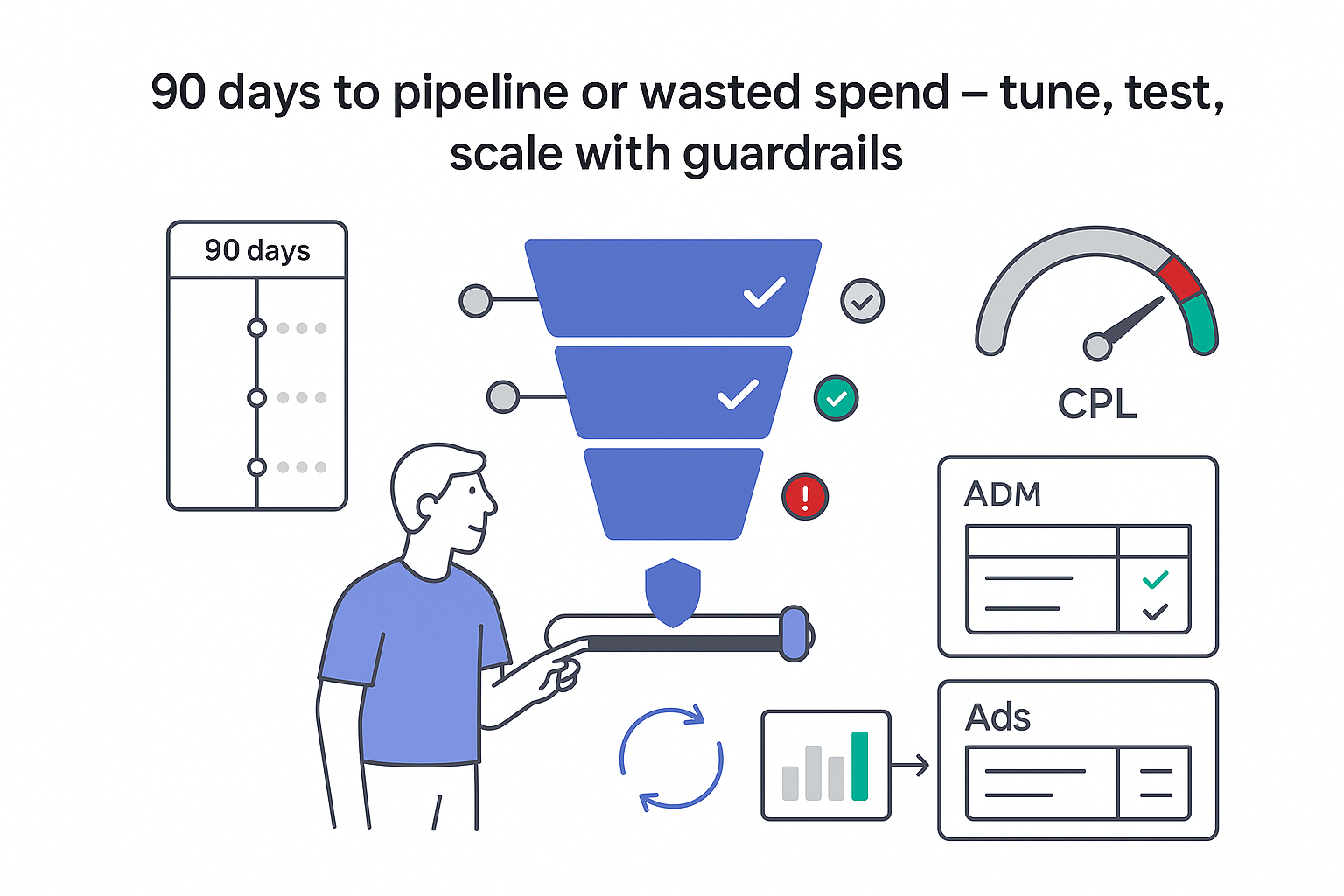

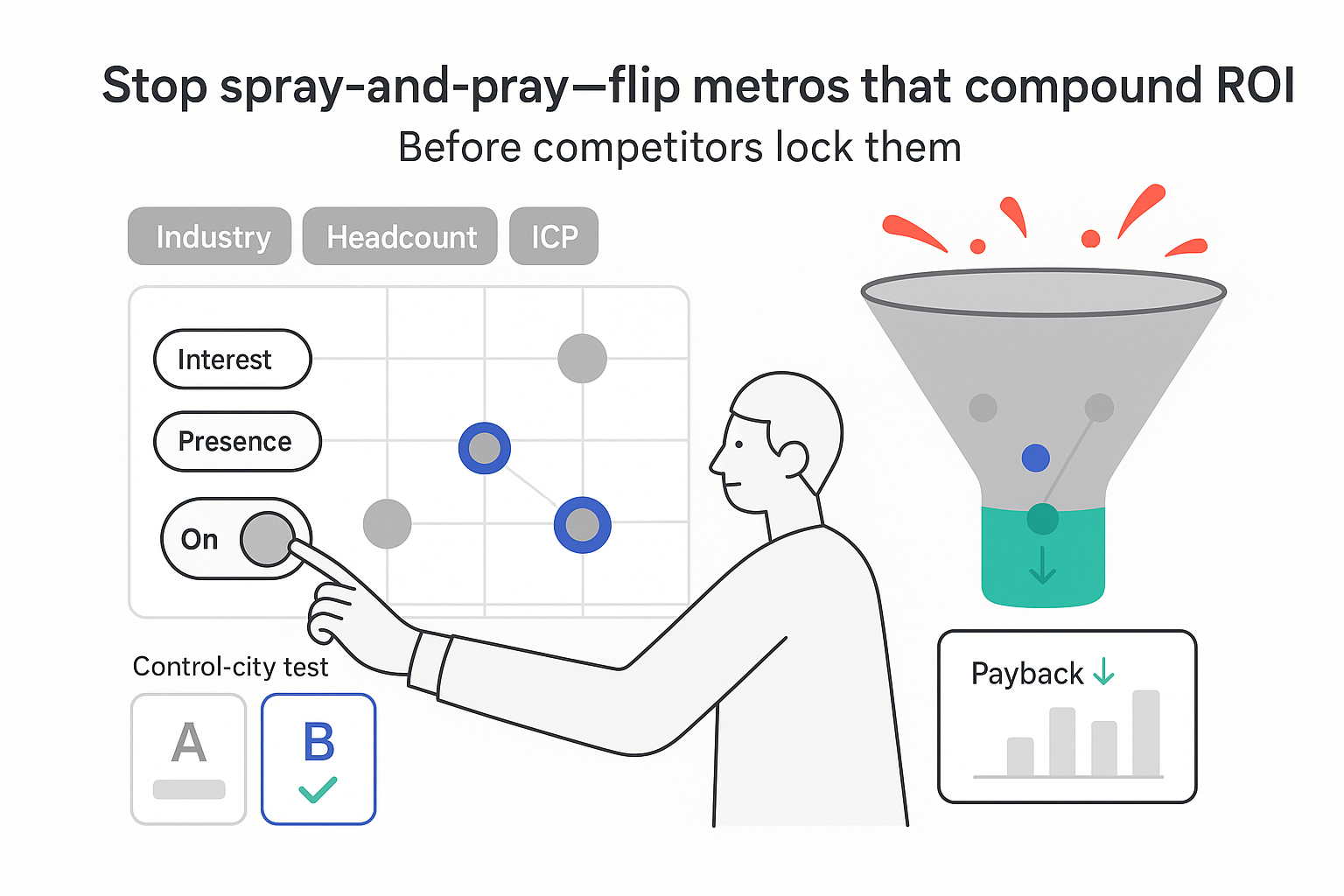
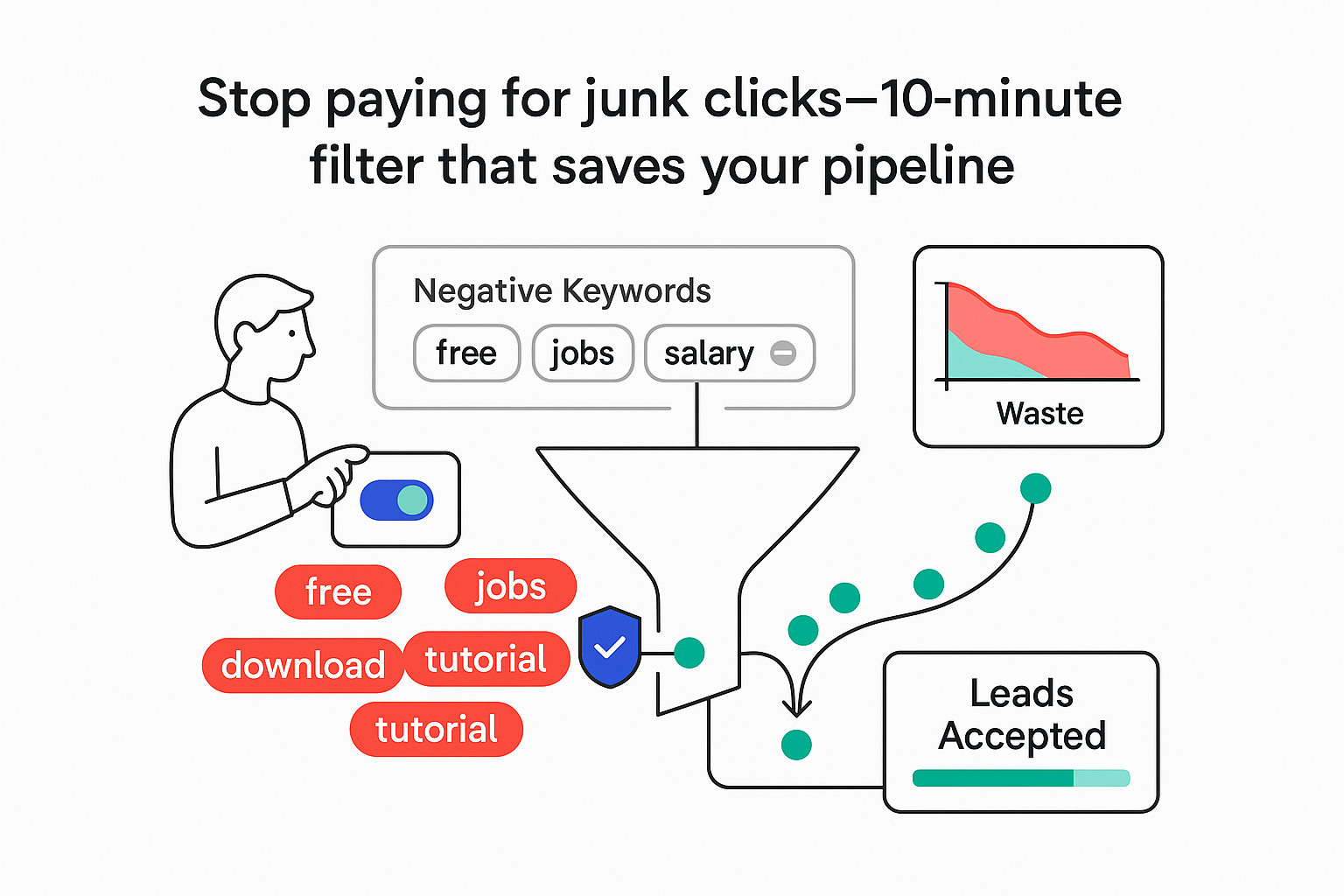
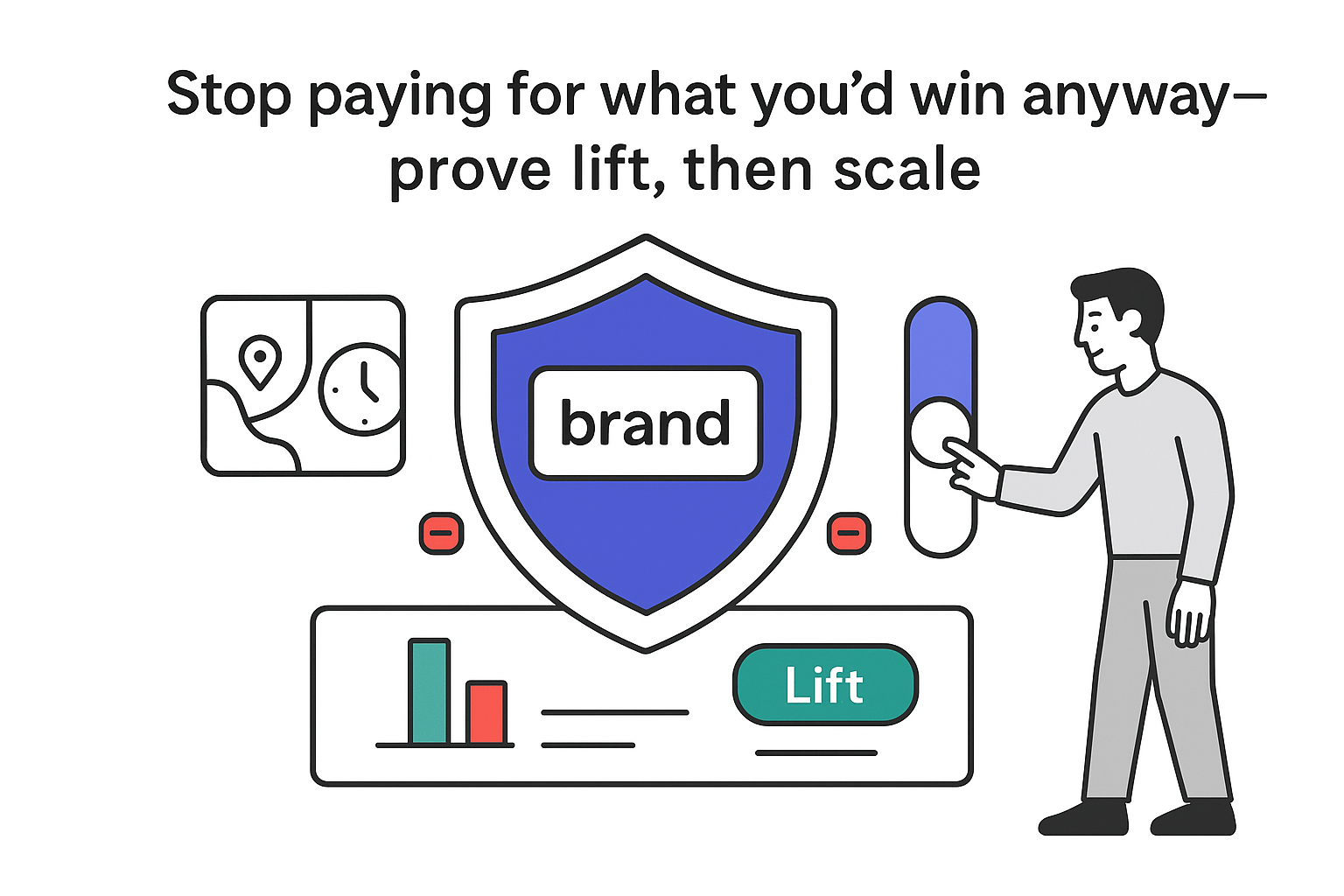
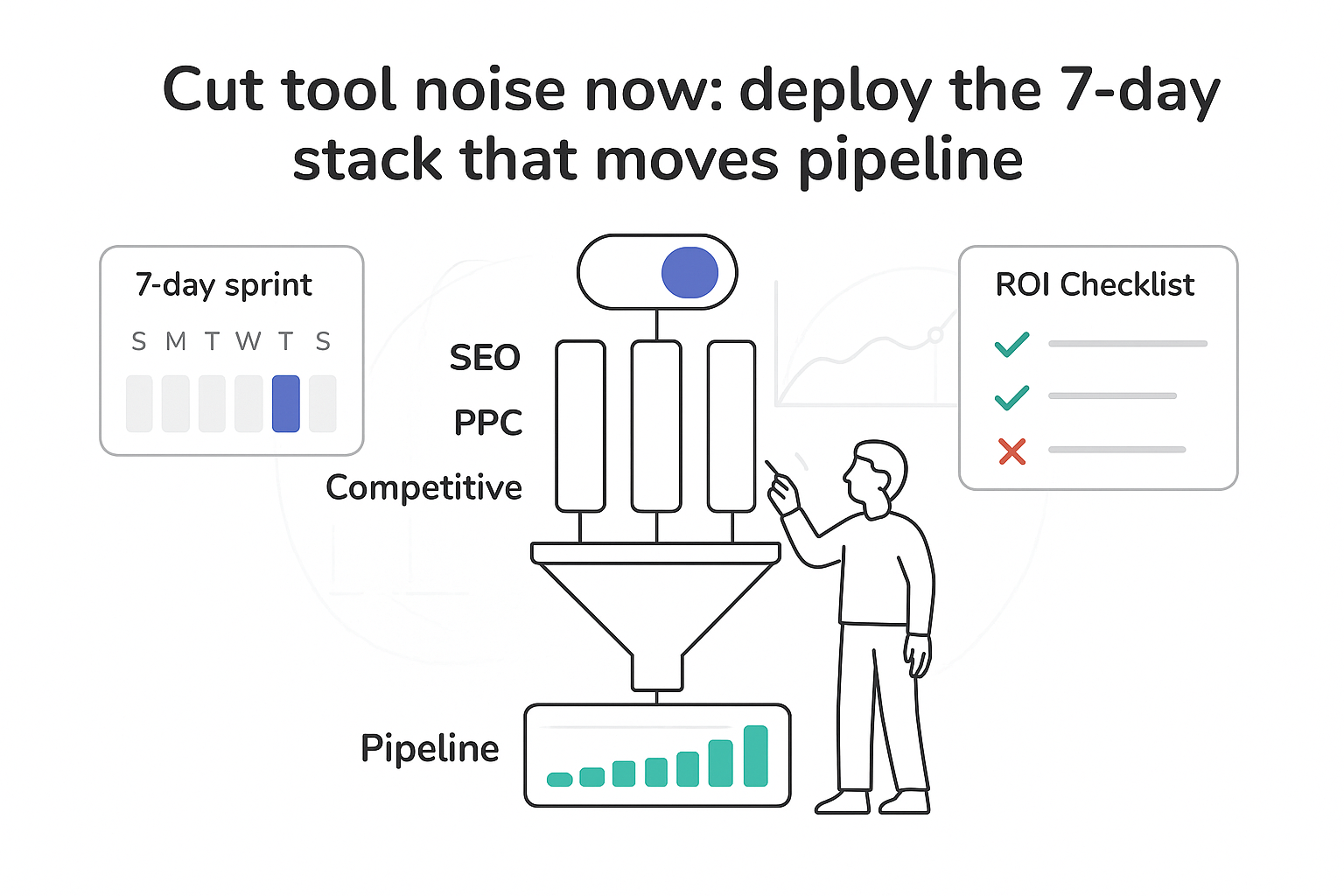
.svg)